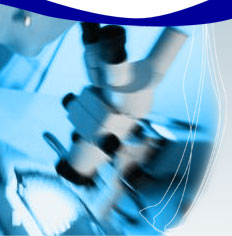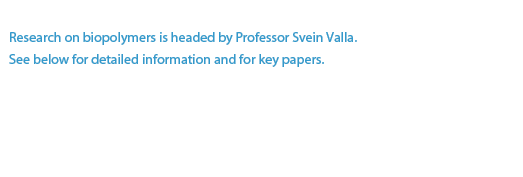
 Biopolymers
Biopolymers
The main work in this field at present is on the polysaccharide alginate, which
has several commercial applications. Due to its gelling, water-binding, and
viscosity-enhancing properties alginate is widely used in foods, and has other
industrial applications as different as in textile printing and welding rods.
It is also used for medical purposes, such as encapsulation of cells. One example
of the latter is the use of alginate for the encapsulation of insulin-producing
cells for better treatment of patients suffering from diabetes. We have isolated
alginate over-producing mutants of Pseudomonas fluorescens and are
studying genes involved in the production of the polymer. We are also combining
this knowledge with knowledge of different Pm-promoters (see Gene
Expression) and of the alginate modifying enzymes to engineer production
strains for different types of alginates.
Key Papers
Gimmestad M, Sletta H, Ertesvag H, Bakkevig K, Jain S, Suh SJ, Skjak-Braek G, Ellingsen TE, Ohman DE, Valla S. (2003). The Pseudomonas fluorescens AlgG protein, but not its mannuronan C-5-Epimerase activity, is needed for alginate polymer formation. J Bacteriol. Jun 15;185(12):3515-3523.

 Alginate modifying enzymes
Alginate modifying enzymes
Alginate is a polymer produced by algae and some microorganisms. Our main focus
has been on the mannuronan C-5-epimerases, which determine the structure of
alginate. Azotobacter vinelandii encodes a family of secreted epimerases
in addition to the periplasmic AlgG. We are currently studying the structure-function
relationship of the epimerases. The production of alginate is important for
the A. vinelandii life cycle, and we are studying the expression of different
epimerases in relation to this. We have also been working on the characterization
of several bacterial lyases.
Key Papers
Valla S, Li J, Ertesvag H, Barbeyron T, Lindahl U. Hexuronyl C5-epimerases in alginate and glycosaminoglycan biosynthesis. Biochimie. 2001 Aug;83(8):819-30. Review. PMID: 11530215
Ertesvag
H, Erlien F, Skjak-Braek G, Rehm BH, Valla S. (1998) Biochemical properties
and substrate specificities of a recombinantly produced Azotobacter vinelandii
alginate lyase. J Bacteriol. 1998 Aug;180(15):3779-84. PMID: 9683471; UI: 98348436
.....................

 Bioprospecting
of marine microorganisms
Bioprospecting
of marine microorganisms

 Biosyntesis
of L-Lysin from Methanol
Biosyntesis
of L-Lysin from Methanol

 Engineered
antibiotic synthesis
Engineered
antibiotic synthesis

 Gene
Expression
Gene
Expression

 Osmoregulation
Osmoregulation

 Metabolic
Engineering
Metabolic
Engineering

© 2003 MOLGEN :: designed by: rahmi & trond erik






